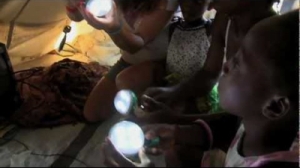Lumina Report Debunks “Simplistic” Thinking About Solar
In August 1961 Dag Hammarskjöld opened a United Nations’ renewable-energy conference in Rome by saying that solar power was the biggest hope for poverty alleviation in the developing world. He believed solar’s time had come and that the world must commit to this path for the benefit of millions. Within a month the U.N. Secretary General had died in a plane crash in Zambia (then Northern Rhodesia).

Individual solar lights helped thousands of isolated Haitians during the 2010 earthquake. Photo courtesy of Agencia Brasil, under Creative Commons licence.
His call for solar-as-poverty-solver never went away but took another 49 years to get its coming-out party. This happened during the 2010 Haiti earthquake when solar lights kept the island from completely shutting down outside small clusters of relief camps. It wasn’t new technology, just the first time that thousands of individual lights were delivered to places cut off by the disaster.
The images of Haitians taking care of their own (and saving thousands) in the middle of the night under tiny dots of light made a point that no amount of United Nations’ film footage could: here was a tool that changed life when nothing else was possible. Tens of millions of Indians using similar lamps during the country’s electrical-grid blackouts this past summer pulled Hammarskjold’s 50-year-old words back into context. Along with health care and education, available energy symbolizes hope and, to an increasing degree, personal control.
Why did this take so long? Organizations like the Solar Electric Light Fund have distributed and promoted solar-generated energy for decades in countries with little access to electricity. This has earned some traction but never enough to create real change.
Here are some of the main reasons why: 1) until 2008, solar hardware wasn’t cheap enough to be financially viable among the world’s poorest people; 2) in-country governments saw no political gain from inexhaustible, efficient energy and therefore weren’t willing to adjust regulatory systems; and 3) no one thought much about examining the sociological effects of traditional energy on actual human beings, in actual homes, in actual villages.
(There is a fourth reason, a neo-colonial belief within wealthy countries that people in poor villages won’t find the resources to pay for high technology, even as cell-phone uptake has proven that to be glaringly incorrect.)
Today, new ways of economic thinking are starting to measure the actual costs of actual human decisions rather than by guessing with mathematical modeling. Solar is one of many fields being analyzed.
Since 2010 information has dribbled out about how traditional fuels that light homes during the evening are poisonous, expensive and dangerous: the same as smoking two packs of cigarettes a day; costing three times more per month than one solar lamp; causing 50 percent of burns and poisoning cases in hospitals.
These are externalities that well-intentioned organizations never paid much attention to, and now a definitive study brings them together to show why solar replacement should be a slam dunk.
The report came out of the office of Evan Mills, a scientist with the Lawrence Berkeley National Laboratory at the University of California. The facility is the American Department of Energy’s national science lab, like the National Research Council in Canada. Mills runs the Lumina Project, which cultivates technologies and markets for off-grid lighting in places without access to electricity.
His report combines costs and benefits of solar-energy replacement from 85 peer-reviewed research papers on the subject. It is the most comprehensive study available to date, analyzing such criteria as incidence of fires and burns as well as victims of unintentional kerosene ingestion (causing seven percent of child deaths in some countries); health problems like cardio-pulmonary disease, cataracts and tuberculosis, among others; and even the effect of low lighting from traditional lamps on the eyes of villagers and on the efficacy of local health-care clinics.

For the first time information on the real effects of traditional-fuel lamps comes together in one report. Photo courtesy of Siemens.
“While the economic and environmental arguments for (solar) replacements for kerosene and other fuel-based lanterns in the developing world are compelling, they are not enough to make the transition as fast or extensive as it could be. Health issues are a parallel driver for everyone in the process, ranging from end-users to policymakers,” Mills explains.
He was surprised that such a large body of research has never been cited by the off-grid lighting community. “Another part of the impetus for this report was my frustration in repeatedly encountering simplistic, incomplete and sometimes downright wrong (but well-intended) health claims by promoters of alternatives to fuel-based lighting.”
Even with the imperatives of Mills’ report, there is still a long way to go before solar lamps hang charging in the sun outside most homes in the developing world. Because this is a consumer issue, governments can’t erect too many barriers to adoption but distribution remains the biggest problem.
This is one reason why Mills will take his report to Dakar, Senegal, in mid-November and present it to the Off-Grid Lighting Business Conference and Trade Fair. The Lighting Africa event is now firmly focussed on distribution although the bureaucratic status quo of trade fairs can suck the energy out of even the most vibrant industry. This is exactly what the solar space does not need.
If it is to fulfill Hammarskjold’s prophecy of hope, everyone in the industry must look past the fragmented prologue prior to 2010 and focus on where the developing world’s new solar narrative is leading.
You can give a helping hand by becoming part of Chocolate Moose Media’s Solar Campaign on Indiegogo.





1 Comment
[…] For the full story about Mills’ report and its implication, see http://cultureshift.tv/2012/10/23/lumina-report-debunks-simplistic-thinking-about-solar/. […]